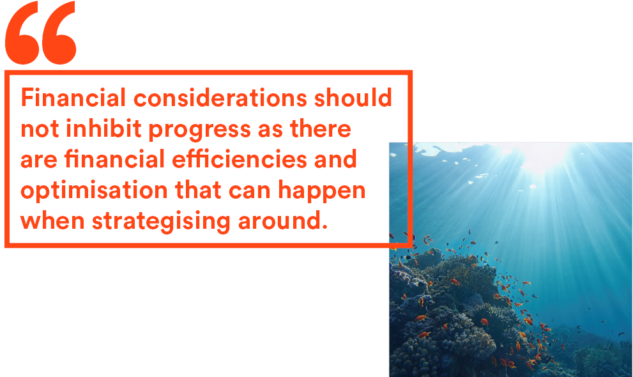ESG Lab | Climate considerations in the investment lifecycle

Climate considerations in the investment lifecycle have taken front and centre stage for many investors. In 2020, over 8,000 suppliers disclosing through CDP (Carbon Disclosure Project) reported that US$1.26 trillion of revenue is likely to be at risk over the next five years due to climate change, deforestation and water insecurity1. Investors are taking note.
Following our successful ESG Labs on Plastics in 2019 and Supply Chain in 2020, PAI organised its first virtual ESG Lab in 2021. It was held on the back of the launch of our new ESG virtual platform (esglab.paipartners.com), which this year has been focused on climate considerations in the investment lifecycle. We gathered 50+ attendees from various LPs, GPs, and corporates from around the world to join in on the discussion and tune in to the insights from our main speakers on investment climate considerations:
- Adam Goehner: Senior Manager ESG Strategy Risk at BCI, a Canadian institutional investor and PAI LP with $200 billion in managed assets
- Minna Lyijynen: Group Manager Sustainability at Refresco, the world’s largest independent bottler and a PAI portfolio company since 2018
- Thomas Carlier: ESG Associate at PAI Partners, a leader in ESG in private equity
In this virtual ESG lab we addressed the question: from origination to exit, how do we best include climate considerations in the investment lifecycle?
Climate Due Diligence: taking a materiality-based approach
When considering climate related issues during the due diligence process, LPs are faced with the challenge of approaching climate change in their portfolios starting from a total portfolio level before zooming into all companies, across all sectors and geographies. This requires taking into consideration the impact different climate future scenarios may have on financial returns and understanding if a company has a long-term strategy that is resilient to the potential uncertainty climate change poses. These uncertainties are often key issues that can impact revenue.
When asked about BCI’s approach to investment due diligence, as an institutional investor and LP, and specifically about where there was a need to build confidence on climate related issues, Adam Goehner shared his simple, yet powerful approach: “we always take a materiality-based approach.” A materiality-based approach means going one step beyond just cost drivers and revenues; it requires finding data on how a climate or other ESG issue is expected to change over time and building that data into financial models. Adam elaborated on how at BCI they look not only at a company in the context of core expenses and core revenue drivers, but also at what the company’s long-term strategy is to mitigate the uncertainty climate change poses and how the company plans to make money based on those potential futures. Interestingly, Adam went on to say that “our modelling suggests that a low carbon economy provides the best potential future financially, socially, and environmentally and will result in the best long-term performance for our pension plans…but we need to be cognisant that there are other potential outcomes (2 degrees+) and we need to factor those physical climate risks into decision making as well.”
Minna Lyijynen provided a practical perspective on what an investor’s materiality-based approach looks like from the corporate level, based on her experience at Refresco as a PAI portfolio company, stating “when you look at climate, it is based on materiality… energy, water, transport, packaging.” She echoed Adam’s choice for a materiality-based approach by explaining that “being a large beverage manufacturing company, when you talk about energy, water, waste, transport, there is also a cost element there, so optimising processes always has the double benefit on costs and environmental impact.”

Ownership: investing in people and creating value through ESG
alue creation through ESG lacks a standardised definition. In order to take practical steps, aligned with the materiality-based approach, Adam articulated that “when we think about value creation (through ESG), in the private equity context, we really think about what are the meaningful or intentional steps we can take as investors to help our companies execute their long-term strategies.” Adam outlined that those steps can come in a lot of different ways, whether in terms of risk reduction or supporting additional reinvestment in a business.
Adam and Minna both went on to point out a key role of investors in climate investments: setting common priorities and supporting value creation not only on the environmental side, but on the human capital side as well.
Minna further unpacked this notion by elaborating on how she “always likes to also take one step back” indicating “absolutely the reporting is important, and you need to demonstrate performance, but in the end really what will make a difference is that sustainability becomes a matter for everyone in the organisation.” Both speakers agreed that strategy and vision will make us sustain on the long term, but only when there is real investment in the human capital and systems do climate initiatives deliver value creation.
Value Chains
Both speakers raised the point that investors must be ready to not only work with a portfolio company, but with its whole value chain. While committing to carbon neutral continues to be a top-of-mind concept, many companies are looking to be carbon neutral by buying offsets. Adam stated that he is “sceptical of just buying offsets as a long-term strategy” and that investors need to guide companies to take careful and specific steps to reduce their emissions in their own way, not just by buying offsets. This reduction, Minna added, is usually also a cost reduction lever. Additionally, integrating climate considerations in the business model allows businesses to open new revenue segments. Investors must support corporates not only through strategy but through reinvestment in initiatives that will continue to drive this value over the long term – both environmental and social.
Adam pointed out that historically ESG considerations are often thought of as a trade-off for financial performance, but Minna painted the picture of operations optimisation in terms of energy use, water consumption, transport and logistics, managing changeovers, managing run sizes, improving packaging etc. She added that improving these material climate elements can be an overall benefit to the business. She went a step further to discuss not just immediate operations and production, but the supply chain implications: both for the environment and business. A business that can make material climate and other sustainability improvements will also be a more attractive supplier. As more and more companies face societal pressure and demands to not only be less unsustainable but also to truly transition to sustainable business models and supply chains, there is a stark shift from the notion of ESG as a trade-off to one where ESG is seen as a competitive advantage.
ESG requirements are here to stay
During the public Q&A, when asked how she expects climate considerations to impact a company’s access to capital in the future, Minna stated “I think it is clear that ESG requirements, including climate, are not going to go away. On the contrary, I expect there will be an increased focus on companies disclosing non-financial information. In addition to financial KPIs, ESG KPIs will continue to play a more important role in all aspects of the business, including access to capital markets.”
She further elaborated on how, long-term, the reporting aspect is very important as businesses and investors need to see demonstrable performance, but in the end, what will really make a difference is when ESG, sustainability, and climate matters become a priority for everyone in the organisation.
